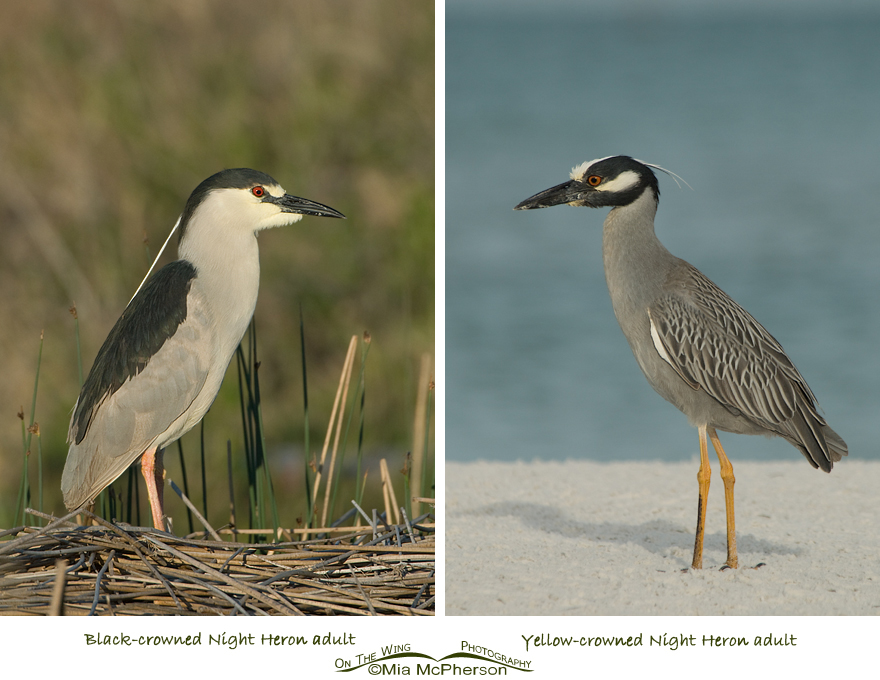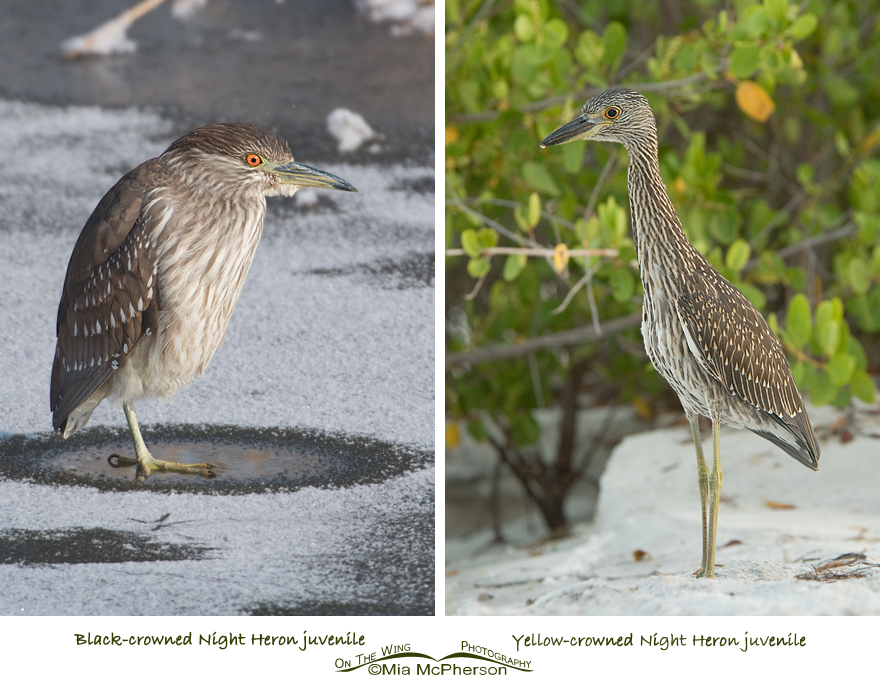
The adult Black-crowned and Yellow-crowned Night Herons aren’t terribly difficult to tell apart though the juveniles can be more of a challenge.
Black-crowned Night Herons have red eyes, a black crown and white plume, a short white to pale gray neck, a very pale gray belly, a solid black back and pale yellow legs that a red during breeding season. Black-crowned Night Herons have a black bill that is shorter and more slender than a Yellow-crowned Night Heron. They appear chunky and squat compared to a Yellow-crowned Night Heron.
Yellow-crowned Night Herons have orange-red eyes, a white crown with a slight yellow tint & white plume, they have a black head with a white cheek patch, a long slender gray neck and belly, a gray back with a pattern and yellow legs. Yellow-crowned Night Herons have a thick black long bill. They appear slender compared to a Black-crowned Night Heron.

The juveniles are slightly more difficult to ID but some features make them easier to identify.
Juvenile Black-crowned Night Herons are chunky and squat like the adults and have short necks. The bill of a juvenile is dark on top and green to yellowish on the bottom, the lores are sometimes a greenish color and the wings have large white spots on a brown back.
Juvenile Yellow-crowned Night Herons are slender in appearance and have long slender necks. The bill of a juvenile is mostly black and the back and wings have fine spots and the overall color is darker than a juvenile Black-crowned Night Heron.
Additionally, geographic location should be taken into account when making an identification in that Black-crowned Night Herons have a much larger range that covers most of the United States into southern Canada, Mexico and the Caribbean. Yellow-crowned Night Herons are found mainly on the east coast of the United States, Mexico and the Caribbean.
Comparing Black-crowned and Yellow-crowned Night Herons isn’t all that difficult if you know what to look for.
Life is good.
Mia
Click here to see more of my Black-crowned Night Heron photos plus facts and information about this species. Click here to see more of my Yellow-crowned Night Heron photos plus facts and information about this species.





Great tutorial Mia! We have plenty of Black-crowned around here, but sometimes Yellow-crowned have been spotted! I’ve often wondered if I would know if I was seeing a Yellow-crowned! It really helps to see them side by side & for you to point out the differences!
Thank you Karen!
Mia, what a wonderful post comparing these 2 species! Very well done and informative.
Thanks Kathie!
Great comparison!
Thank you Matthew.
Awesome pics, Mia! Having pictures of the birds side by side is a great way to recognize the differences and memorize how to tell the differences between them.
Thanks Sam, I tried to pick images that would show the differences well.
fantastic !!! thanks mia
Thank you Eric
It’s so easy when they’re side-by-side!
Thanks Charlotte.
These are excellent comparison photographs, Mia! Very cool birds!
Thank you Julie.
Quite a difference when you actually see them side by side. Nice comparison Mia.
Thanks Sherry!
This is so instructional and well designed Mia, thanks. When I was in FL, I saw a Juvenile Yellow-crowned Night Heron and got the ID messed up.
Maria, I got the ID’s messed up too when I first started photographing them in Florida.
Excellent article and terrific comparison photos, Mia.
Thank you Scott!
Back in the 80’s and 90’s there was a large rookery of herons ( I thought black crowned at the time) at the National Zoo in Washington, DC! I was visiting with my sons who were quite young at the time, so I couldn’t stay as long as I might have to watch! Impressively noisy!
Appreciate the comparative looks, great tutorial. Thank you!
Thanks Fern, I wonder if the rookery is still there at the National Zoo.
Excellent side-by-side format Mia!
Thanks Robert!
Great comparison photos Mia, I love hoe you’ve got the respective species squaring off with its cousin. Family rivalry!
Laurence, I wonder if where their ranges overlap if there is some sparring that goes on for territory, had not thought of that until now.
Brilliant shots Mia.
Thank you Bob!